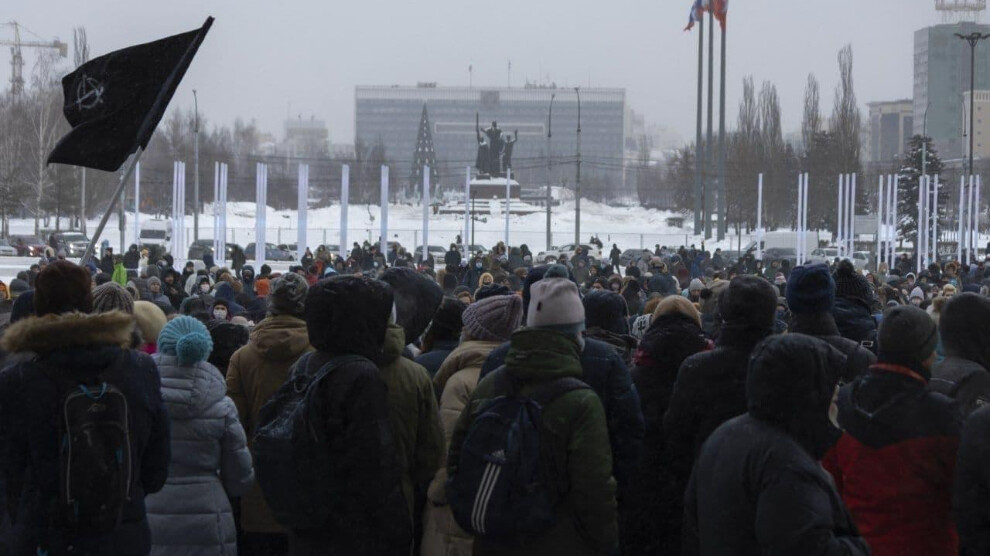Protests in Russia: deep roots and problems
The images of mass protest actions in Russia were spreaded over the world. The events of January 23 became the most massive.
The images of mass protest actions in Russia were spreaded over the world. The events of January 23 became the most massive.

The images of mass protest actions in Russia were spreaded over the world. The events of January 23 became the most massive. Thousands of people gathered in the streets. Then it repeated on Jauary 31 while in smaller scale. Smaller but still visible actions took place on the day when oppositional politician Alexey Navalny had returned to Moscow as well as in the days of court hearing on his cases.
Authorities showed a harsh reaction. Riot police (OMON in Russian) used sticks, teargas, shockers and beating for spreading and suppressing the protest. During the days of actions there were more than 10 000 of people arrested in sum. Several thousands were put under administrative detention for several days or weeks. Up to date there are about 90 criminal cases opened for «using force against the police», «posing infectional threat» and other reasons. It won't be exaggeration to say that Russian authorities showed clearly their authoritarian and repressive essence during its fight against the protesters in January-February 2021.

The key figure of the protests is Alexey Navalny. He is an oppositional leader with long experience, founder and actual head of The Anti-Corruption Foundation. Navalny also oganized the network of «headquarters» of his supporters in many regions of Russia. The political position of Navalny can be labeled as populism. He tries to appeal nationalist audience by using the discourse of combatting «illigal» migration and promoting visa regime with certain post-Soviet countries.
At the same time Navalny intervene the «Left» agenda by criticizing luxuriance of the Rulling class and restrictive pension reform. In his presidency problem for electorial campaign of 2018 he promised to double state funding of healthcare and education, as well as to raise minimum salary.
However Navalny is usually interpreted as liberal politician. His main target group is young people aspiring for more democratic and «Western» lifestyle.
An immediate reason for current political crisis in Russia is series of events related with Alexey Navalny. He was poisoned and then sent for medical treatment to Germany. Later there came an investigation arguing that it was an assasination attempt by Russian secret services. By January 17 Navalny returned to Russia and was immediately arrested. His arrest was performed with clear violation of judicial procedures. Next day his fellow colleagues published the investigation film about splendid palace allegedly intended for use by president Putin. All this combination resulted with comparatively massive social disturbance and protests on the streets.

However deeper roots of the protests are not at all reduced to Alexey Navalny personally. Starting since 2014 Russia is in a state of almost permanent worsening of the economic situation. New presedential term for Putin in 2018 was soon marked by pension reform meant retirement-age increase. In parallel the regime of personal power of the president progressively took shape. Repressions have become more intense. Number of political prisoners has grown dramatically. Comparatively well-known are the prosecutions of anarchists during «The Network» case and the case of Azat Miftakhov.
As well as in many countries of the world the hardships of coronavirus epidemic along with its social and economic consequenses resulted in sharp increase of mass dissatisfaction and then to events on the streets.
Protests take place contrary to prohibitions of authorities. Using phisical force is always started by the police. However this time we see more intense phisical resistance from the side of the protesters against the police. But it still has sporadic and rare character. Protesters didn't show the readiness to continue actions more than one day at a stretch and not to desperse with the fall of the night.
Important specific of this protest wave is more active participation of the people in rigions. Such big cities as Yekaterinburg, Vladivostok, Irkutsk and several others saw the actions of the scale not that much lower than «capitals» Moscow and Saint-Petersburg.

The Headquarters of Navalny are the network and organizational frame of the movement of his supporters. This structure appeared to be the main initiator and coordinator of these protests. However their capacity is under doubt. After two weekends of mass protests leaders of the Navalny movement declared the end of the mobilization.
Their latest initiative is flashmob executed on February 14: people came to the yards of their blocks in the cities and turned on the flashlights in support of Alexey Navalny and other political prisoners. The slogan of the flashmob was «Love is stronger than fear». In different cities of Russia thousands of people took part in this initiative.
Anarchist and socialist groups participated in the protests. They were especially visible in cities of Izhevsk, Perm and Irkutsk. Their topics were inequality, the demand for social justice and the release of political prisoners. One of their slogans: «Not for Navalny but for the people!»
The highest point of the protests was on January 23. Now we see obvious decrease. At the same time it is obvious as well that this decrease is temporal and new waves are very likely coming soon. This situation once again uncovers the necessity of organized political movement not burdened by personalist tendency unlike we have it in case of Alexey Navalny. The movement which will be able to organize the people for resolute struggle for social justice.